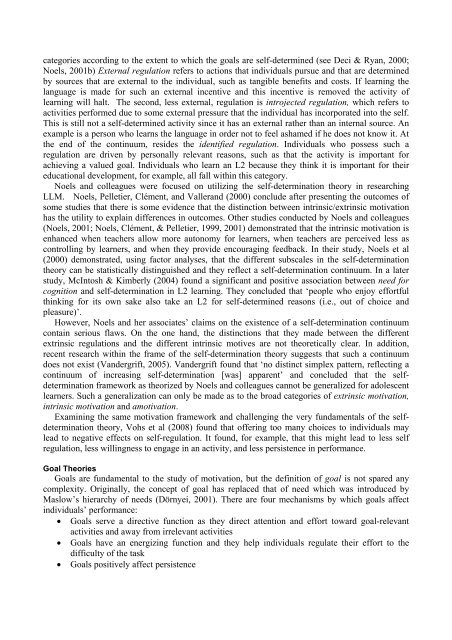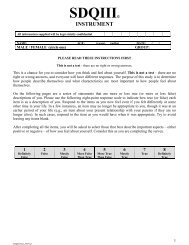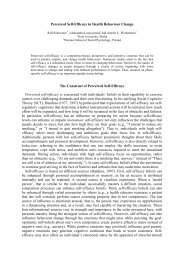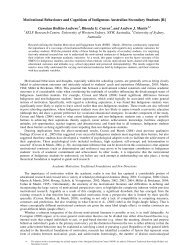A Critical Appraisal of Language Learning Motivation Theories Faris ...
A Critical Appraisal of Language Learning Motivation Theories Faris ...
A Critical Appraisal of Language Learning Motivation Theories Faris ...
You also want an ePaper? Increase the reach of your titles
YUMPU automatically turns print PDFs into web optimized ePapers that Google loves.
categories according to the extent to which the goals are self-determined (see Deci & Ryan, 2000;<br />
Noels, 2001b) External regulation refers to actions that individuals pursue and that are determined<br />
by sources that are external to the individual, such as tangible benefits and costs. If learning the<br />
language is made for such an external incentive and this incentive is removed the activity <strong>of</strong><br />
learning will halt. The second, less external, regulation is introjected regulation, which refers to<br />
activities performed due to some external pressure that the individual has incorporated into the self.<br />
This is still not a self-determined activity since it has an external rather than an internal source. An<br />
example is a person who learns the language in order not to feel ashamed if he does not know it. At<br />
the end <strong>of</strong> the continuum, resides the identified regulation. Individuals who possess such a<br />
regulation are driven by personally relevant reasons, such as that the activity is important for<br />
achieving a valued goal. Individuals who learn an L2 because they think it is important for their<br />
educational development, for example, all fall within this category.<br />
Noels and colleagues were focused on utilizing the self-determination theory in researching<br />
LLM. Noels, Pelletier, Clément, and Vallerand (2000) conclude after presenting the outcomes <strong>of</strong><br />
some studies that there is some evidence that the distinction between intrinsic/extrinsic motivation<br />
has the utility to explain differences in outcomes. Other studies conducted by Noels and colleagues<br />
(Noels, 2001; Noels, Clément, & Pelletier, 1999, 2001) demonstrated that the intrinsic motivation is<br />
enhanced when teachers allow more autonomy for learners, when teachers are perceived less as<br />
controlling by learners, and when they provide encouraging feedback. In their study, Noels et al<br />
(2000) demonstrated, using factor analyses, that the different subscales in the self-determination<br />
theory can be statistically distinguished and they reflect a self-determination continuum. In a later<br />
study, McIntosh & Kimberly (2004) found a significant and positive association between need for<br />
cognition and self-determination in L2 learning. They concluded that ‘people who enjoy effortful<br />
thinking for its own sake also take an L2 for self-determined reasons (i.e., out <strong>of</strong> choice and<br />
pleasure)’.<br />
However, Noels and her associates’ claims on the existence <strong>of</strong> a self-determination continuum<br />
contain serious flaws. On the one hand, the distinctions that they made between the different<br />
extrinsic regulations and the different intrinsic motives are not theoretically clear. In addition,<br />
recent research within the frame <strong>of</strong> the self-determination theory suggests that such a continuum<br />
does not exist (Vandergrift, 2005). Vandergrift found that ‘no distinct simplex pattern, reflecting a<br />
continuum <strong>of</strong> increasing self-determination [was] apparent’ and concluded that the selfdetermination<br />
framework as theorized by Noels and colleagues cannot be generalized for adolescent<br />
learners. Such a generalization can only be made as to the broad categories <strong>of</strong> extrinsic motivation,<br />
intrinsic motivation and amotivation.<br />
Examining the same motivation framework and challenging the very fundamentals <strong>of</strong> the selfdetermination<br />
theory, Vohs et al (2008) found that <strong>of</strong>fering too many choices to individuals may<br />
lead to negative effects on self-regulation. It found, for example, that this might lead to less self<br />
regulation, less willingness to engage in an activity, and less persistence in performance.<br />
Goal <strong>Theories</strong><br />
Goals are fundamental to the study <strong>of</strong> motivation, but the definition <strong>of</strong> goal is not spared any<br />
complexity. Originally, the concept <strong>of</strong> goal has replaced that <strong>of</strong> need which was introduced by<br />
Maslow’s hierarchy <strong>of</strong> needs (Dörnyei, 2001). There are four mechanisms by which goals affect<br />
individuals’ performance:<br />
Goals serve a directive function as they direct attention and effort toward goal-relevant<br />
activities and away from irrelevant activities<br />
Goals have an energizing function and they help individuals regulate their effort to the<br />
difficulty <strong>of</strong> the task<br />
Goals positively affect persistence





